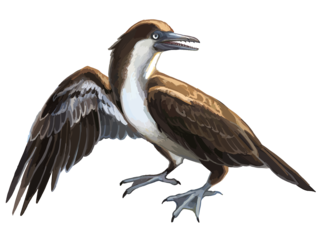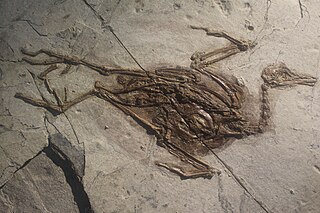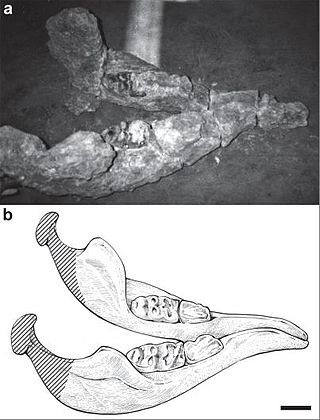
Vetulicolia is a group of bilaterian animals encompassing several extinct species from the Cambrian, and possibly Ediacaran, periods. As of 2023, the majority of workers favor placing Vetulicolians in the stem group of the Chordata,, but some continue to favor a more crownward placement as a sister group to the Tunicata. It was initially erected as a monophyletic clade with the rank of phylum in 2001, with subsequent work supporting its monophyly. However, more recent research suggests that vetulicolians may be paraphyletic and form a basal evolutionary grade of stem chordates.

Struthionidae is a family of flightless birds, containing the extant ostriches and their extinct relatives. The two extant species of ostrich are the common ostrich and Somali ostrich, both in the genus Struthio, which also contains several species known from Holocene fossils such as the Asian ostrich. The common ostrich is the more widespread of the two living species, and is the largest living bird species. The extinct genus Pachystruthio from the Late Pliocene-Early Pleistocene of Eurasia is one of the largest birds ever.

Ostriches are large flightless birds. Two living species are recognised, the common ostrich, native to large areas of sub-Saharan Africa, and the Somali ostrich, native to the Horn of Africa.

The Qijia culture was an early Bronze Age culture distributed around the upper Yellow River region of Gansu and eastern Qinghai, China. It is regarded as one of the earliest bronze cultures in China.

Yanornis is an extinct genus of fish-eating Early Cretaceous birds. Two species have been described, both from Liaoning province, China: Yanornis martini, based on several fossils found in the 120-million-year-old Jiufotang Formation at Chaoyang, and Yanornis guozhangi, from the 124-million-year-old Yixian Formation.

Gansus is a genus of aquatic birds that lived during the Aptian age of the Early Cretaceous (Aptian-Albian) period in what are now Gansu and Liaoning provinces, western China. The rock layers from which their fossils have been recovered are dated to 120 million years ago. It was first described in 1984 on the basis of an isolated left leg. It is the oldest-known member of the Ornithurae, the group which includes modern birds (Neornithes) and extinct related groups, such as Ichthyornis and Hesperornithes.
The Xiagou Formation is the middle strata of the Xinminbao Group. It is named for its type site in Xiagou, in the Changma Basin of Gansu Province, northwestern China and is considered Early Cretaceous in age. It is known outside the specialized world of Chinese geology as the site of a Lagerstätte in which the fossils were preserved of Gansus yumenensis, the earliest true modern bird.

Sinotherium is an extinct genus of single-horned elasmotheriine rhinocerotids that lived from the late Miocene to Early Pliocene. It was ancestral to Elasmotherium, demonstrating a very important evolutionary transition from nasal-horned elasmotheriines to frontal-horned elasmotheriines. Its fossils have been found in the Karabulak Formation of Kazakhstan, lower jaw and teeth have been found in Mongolia, and a partial skull is known from the upper part of the Liushu Formation of western China. Sinotherium diverged from the ancestral genus, Iranotherium, first found in Iran, during the early Pliocene. Some experts prefer to lump Sinotherium, and Iranotherium into Elasmotherium.

Confuciusornithidae is an extinct family of pygostylian avialans known from the Early Cretaceous, found in northern China. They are commonly placed as a sister group to Ornithothoraces, a group that contains all extant birds along with their closest extinct relatives. Confuciusornithidae contains four genera, possessing both shafted and non-shafted (downy) feathers. Some specimens probably referable to this clade represents one of the earliest known fossil evidence of primary feather moulting. They are also noted for their distinctive pair of ribbon-like tail feathers of disputed function.
Paleontology or palaeontology is the study of prehistoric life forms on Earth through the examination of plant and animal fossils. This includes the study of body fossils, tracks (ichnites), burrows, cast-off parts, fossilised feces (coprolites), palynomorphs and chemical residues. Because humans have encountered fossils for millennia, paleontology has a long history both before and after becoming formalized as a science. This article records significant discoveries and events related to paleontology that occurred or were published in the year 1997.
Paleontology or palaeontology is the study of prehistoric life forms on Earth through the examination of plant and animal fossils. This includes the study of body fossils, tracks (ichnites), burrows, cast-off parts, fossilised feces (coprolites), palynomorphs and chemical residues. Because humans have encountered fossils for millennia, paleontology has a long history both before and after becoming formalized as a science. This article records significant discoveries and events related to paleontology that occurred or were published in the year 2005.
Miomachairodus is an extinct genus of large machairodontine containing only a single species, Miomachairodus pseudailuroides. It is mainly known from Middle Miocene-age fossils in Turkey and persisted until the early Late Miocene (Vallesian). Fossils of this machairodont have been found in the Vallesian-age Bahe Formation in Shaanxi, China, and Yeni Eskihisar in Anatolia. This Turkish site is of Miocene age and is well known for its pollen studies.

Zygolophodon is an extinct genus of mammutid proboscidean that lived during the Miocene in Africa, Eurasia, and North America.

Sinomammut is a mammutid proboscidean from the Miocene of China. Only one species, S. tobieni, is known, named in 2016.
Sivapanthera is a prehistoric genus of felid described by Kretzoi in 1929. Species of Sivapanthera are closely related to the modern cheetah but differ from modern cheetahs by having relatively longer brain cases, flatter foreheads, narrower nostrils and larger teeth. In many ways, skulls of Sivapanthera show similarity to that of the puma, or even those of Panthera. Scholars differ on the validity of this genus, while some think that it should be treated as a distinct genus, others think that its members should be treated as members of the Acinonyx genus, or even as subspecies of Acinonyx pardinensis.

The Liushu Formation is a geological formation in Gansu province, China that spans up to 100 m thick and is widely distributed within the Linxia Basin, with a paleomagnetic age between 11 and 6.4 mya.
This paleobotany list records new fossil plant taxa that were to be described during the year 2022, as well as notes other significant paleobotany discoveries and events which occurred during 2022.

Ballusia is a genus of small bear from the Early Miocene epoch, about 20.5-18 million years ago. Fossil remains attributed to the genus have been uncovered in Europe (Poland) and Asia. The genus Ballusia was established in 1998 on the basis of different fossils originally classified as various species of the genera Ursavus and Hemicyon, with B. elmensis as the type species. The exact relationship of Ballusia to "true" bears are not yet fully understood: many palaeontologists have classified it as a primitive member of Ursinae, but its known skeletal elements have some features in common with the extinct bear subfamily Hemicyoninae. Because of this, some researchers refer Ballusia as "Ursidae incertae sedis". Ginsburg and Morales regarded B. elmenensis as ancestral to Ursavus, as did Marciszak and Lipecki, even though the temporal range of the two genera seems to have overlapped.















